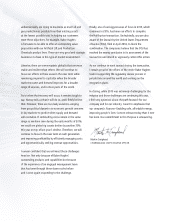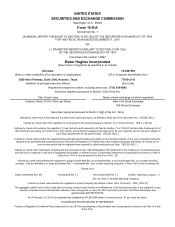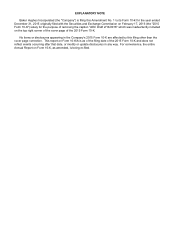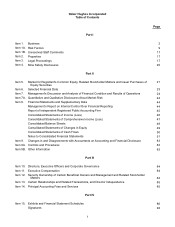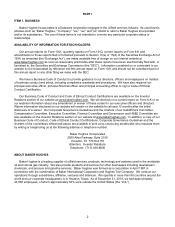Baker Hughes 2015 Annual Report Download - page 14
Download and view the complete annual report
Please find page 14 of the 2015 Baker Hughes annual report below. You can navigate through the pages in the report by either clicking on the pages listed below, or by using the keyword search tool below to find specific information within the annual report.5
well as improve plant safety and equipment reliability. Process and pipeline services works to improve efficiency
and reduce downtime with inspection, pre-commissioning and commissioning of new and existing pipeline systems
and process plants.
MARKETING, COMPETITION AND CONTRACTING
We market our products and services within our four geographic regions on a product line basis primarily
through our own sales organizations. We provide technical and advisory services to assist in our customers’ use of
our products and services. Stock points and service centers for our products and services are located in areas of
drilling and production activity throughout the world.
Our primary competitors include the major diversified oilfield service companies such as Schlumberger,
Halliburton and Weatherford International, where the breadth of service capabilities as well as competitive position
of each product line are the keys to differentiation in the market. We also compete with other companies who may
participate in only a few of the same product lines as us, such as National Oilwell Varco, Ecolab, Newpark
Resources and FTS International. Our products and services are sold in highly competitive markets and revenue
and earnings are affected by changes in commodity prices, fluctuations in the level of drilling, workover and
completion activity in major markets, general economic conditions, foreign currency exchange fluctuations and
governmental regulations. We believe that the principal competitive factors in our industries are product and service
quality, reliability and availability, health, safety and environmental standards, technical proficiency and price.
Our customers include the large integrated major and super-major oil and natural gas companies, U.S. and
international independent oil and natural gas companies and the national or state-owned oil companies. No single
customer accounts for more than 10% of our business. While we may have contracts with customers that include
multiple well projects and that may extend over a period of time ranging from two to four years, our services and
products are generally provided on a well-by-well basis. Most contracts cover our pricing of the products and
services, but do not necessarily establish an obligation to use our products and services.
We strive to negotiate the terms of our customer contracts consistent with what we consider to be best
practices. The general industry practice is for oilfield service providers, like us, to be responsible for their own
products and services and for our customers to retain liability for drilling and related operations. Consistent with this
practice, we generally take responsibility for our own people and property while our customers, such as the operator
of a well, take responsibility for their own people, property and all liabilities related to the well and subsurface
operations, regardless of either party’s negligence. In general, any material limitations on indemnifications to us
from our customers in support of this allocation of responsibility arise only by applicable statutes.
Certain states such as Texas, Louisiana, Wyoming, and New Mexico have enacted oil and natural gas specific
statutes that void any indemnity agreement that attempts to relieve a party from liability resulting from its own
negligence (“anti-indemnity statutes”). These statutes can void the allocation of liability agreed to in a contract;
however, both the Texas and Louisiana anti-indemnity statutes include important exclusions. The Louisiana statute
does not apply to property damage, and the Texas statute allows mutual indemnity agreements that are supported
by insurance and has exclusions, which include, among other things, loss or liability for property damage that
results from pollution and the cost of well control events. We negotiate with our customers in the U.S. to include a
choice of law provision adopting the law of a state that does not have an anti-indemnity statute because both Baker
Hughes and our customers generally prefer to contract on the basis as we mutually agree. When this does not
occur, we will generally use Texas law. With the exclusions contained in the Texas anti-indemnity statute, we are
usually able to structure the contract such that the limitation on the indemnification obligations of the customer is
limited and should not have a material impact on the terms of the contract. State law, laws or public policy in
countries outside the U.S., or the negotiated terms of our agreement with the customer may also limit the
customer’s indemnity obligations in the event of the gross negligence or willful misconduct of a Company employee.
The Company and the customer may also agree to other limitations on the customer’s indemnity obligations in the
contract.
The Company maintains a commercial general liability insurance policy program that covers against certain
operating hazards, including product liability claims and personal injury claims, as well as certain limited
environmental pollution claims for damage to a third party or its property arising out of contact with pollution for
which the Company is liable; however, clean up and well control costs are not covered by such program. All of the
insurance policies purchased by the Company are subject to self-insured retention amounts for which we are




